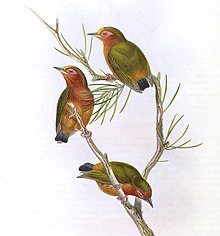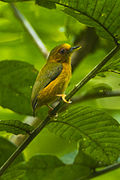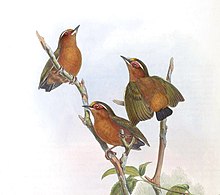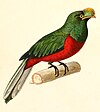Sasia
Appearance
| Sasia | |
|---|---|

| |
| Sasia abnormisby Gould & Richter | |
| Scientific classification | |
| Domain: | Eukaryota |
| Kingdom: | Animalia |
| Phylum: | Chordata |
| Class: | Aves |
| Order: | Piciformes |
| Family: | Picidae |
| Subfamily: | Picumninae |
| Genus: | Sasia Hodgson,1837 |
| Type species | |
| Sasia ochracea[1] Hodgson, 1837
| |
| Species | |
|
3, see text | |

| |
| range of genus | |
Sasiais a genus of birds in the woodpecker familyPicidae,that are native to theOld World.They are very small, virtually tailless woodpeckers, with acrombecornuthatch-like appearance and foraging habits. Their habitat is forest and secondary growth.[2]
These species have a fleshorbital ringand a rounded (in cross-section) upper mandible. They have ten rectrices and only three toes (absent first digit, or hallux).[3]
TheAfrican piculethas sometimes been included in this genus. It has only eightrectricesand four toes in azygodactylarrangement (a weak first digit). It differs from the Asian species in the plumage colour of the adult, but not in the plumage pattern, body anatomy or in habits.[4]
Species
[edit]The genus contains two species:[5]
| Image | Common name | Scientific name | Distribution |
|---|---|---|---|
 |
Rufous piculet | Sasia abnormis | mainlyMalaysiaandIndonesia |
 |
White-browed piculet | Sasia ochracea | mainlandSoutheast Asia |
Gallery
[edit]-
Sasia ochracea
by Gould & Richter -
Close-up of the head
and tail ofS. abnormis
References
[edit]Wikimedia Commons has media related toSasia.
- ^"Picidae".aviansystematics.org.The Trust for Avian Systematics.Retrieved2023-07-26.
- ^Stevenson, Terry; Fanshawe, John (2001).Field guide to the birds of East Africa: Kenya, Tanzania, Uganda, Rwanda, Burundi.London: T. & A.D. Poyser. pp. 280–281.ISBN9780856610790.
- ^Gorman, Gerard (2014).Woodpeckers of the World: The Complete Guide (Helm Photographic Guides).London: Bloomsbury. p. 88.ISBN978-1408147153.
- ^Delacour, J. (January 1951)."The significance of the number of toes in some woodpeckers and kingfishers"(PDF).The Auk.68(1): 49–51.doi:10.2307/4080797.JSTOR4080797.Retrieved20 September2018.
- ^Gill, Frank;Donsker, David;Rasmussen, Pamela,eds. (January 2023)."Woodpeckers".IOC World Bird List Version 13.1.International Ornithologists' Union.Retrieved29 January2023.










